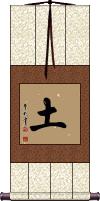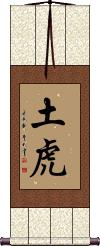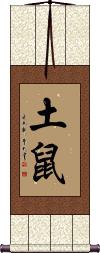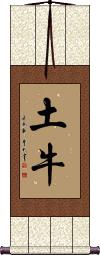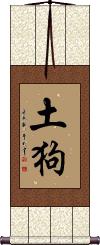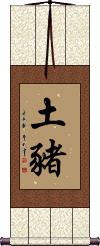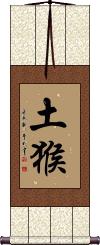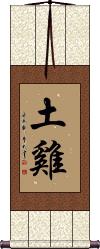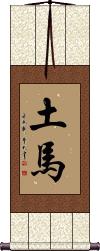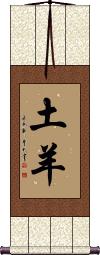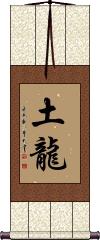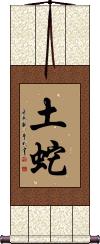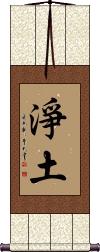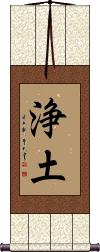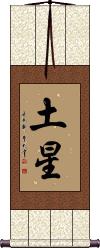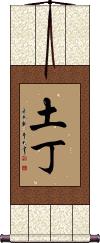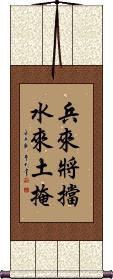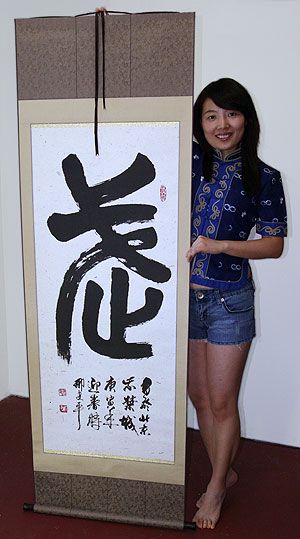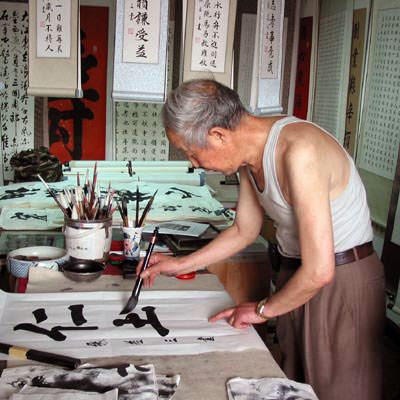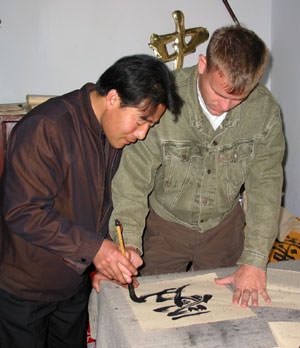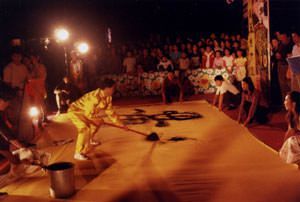Many custom options...
And formats...

土 in Chinese / Japanese...
Buy an 土 calligraphy wall scroll here!
Personalize your custom “土” project by clicking the button next to your favorite “土” title below...
1. Earth
2. Earth Tiger
3. Earth Rabbit
4. Earth Rat
6. Earth Dog
8. Earth Monkey
10. Earth Horse
11. Earth Goat/Sheep
12. Earth Dragon
13. Earth Snake
14. Pure Land / Jodo
15. Saturn
16. Tuding
17. Pure Land Buddhism / Jodo Buddhism
18. Turkey
19. Turkmenistan
21. Duty to Defend and Protect Country
22. Shin Buddhism
23. Five Elements
Earth
(One of the five elements)
土 is earth, soil, ground, or Terra.
Earth is one of the five elements that ancient Chinese believed all things were composed of. These elements are also part of the cycle of Chinese astrology. Every person has both an animal sign, and one of the five elements according to the date of their birth.
Earth Tiger
The Year of the Earth Tiger
Earth Rabbit
The Year of the Earth Rabbit
Earth Rat
The Year of the Earth Rat
Earth Ox/Bull
The Year of the Earth Ox/Bull
Earth Dog
The Year of the Earth Dog
Earth Pig/Boar
The Year of the Earth Pig/Boar
Earth Monkey
The Year of the Earth Monkey
Earth Rooster
The Year of the Earth Rooster
Earth Horse
The Year of the Earth Horse
Earth Goat/Sheep
The Year of the Earth Goat/Sheep
Earth Dragon
The Year of the Earth Dragon
Earth Snake
The Year of the Earth Snake
Pure Land / Jodo
Also a sect of Buddhism
淨土 literally means “pure land” or “clean earth.”
淨土 is also the abbreviated title of a Buddhist sect that involves faith in the rebirth of Buddha Amitabha (Amitābha) in the Western Heaven. Sometimes this sect is translated as “Paradise of the West.” Other titles of this school of Buddhism include Amidism or Elysium.
Pure Land / Jodo
浄土 means “Pure Land.”
This term, “Pure Land” is often associated with the Western Pure Land paradise of Amitabha, also known as the “Buddhist paradise.”
浄土 can also be used as an abbreviation for “Pure Land Buddhism.”
You may see this romanized as Jodo, Joudo, or Jōdo. Some also combine Pure Land into Pureland in English.
This can also be a Japanese surname with the same Jodo or Joudo pronunciation.
Saturn
土星 is the Chinese, Japanese Kanji, and old Korean Hanja for the planet Saturn.
The literal meaning of these characters is “earth star.” The earth character is one of the five elements of Chinese culture. This earth character regards soil or dirt, not the planet Earth.
Saturn has been titled 土星 for at least 2000 years.
Tuding
Pure Land Buddhism / Jodo Buddhism
浄土宗 is the title of Japanese “Pure Land Buddhism.” This form is also romanized/known as “Jodo Shu” (jōdo shū).
Also known as Amidism for the fact that this is a branch of Mahayana (Mahāyāna) Buddhism which focuses on Amitabha (Amitābha) Buddha. This form of Buddhism, along with Chinese characters, came to Japan via China in the 5th century, according to most historians.
Notes:
Pure Land Buddhism is also known as ![]()
![]()
![]()
![]() (jōdo bukkyō).
(jōdo bukkyō).
Some will just express it with just ![]()
![]() (Pure Land).
(Pure Land).
Turkey
Turkmenistan
Body and Earth in Unity
身土不二 (Shindofuni) is originally a Buddhist concept or proverb referring to the inseparability of body-mind and geographical circumstances.
This reads, “Body [and] earth [are] not two.”
Other translations or matching ideas include:
Body and land are one.
Body and earth can not be separated.
Body earth sensory curation.
You are what you eat.
Indivisibility of the body and the land (because the body is made from food and food is made from the land).
Going further, this speaks of our human bodies and the land from which we get our food being closely connected. This phrase is often used when talking about natural and organic vegetables coming directly from the farm to provide the healthiest foods in Japan.
Character notes: 身(shin) in this context does not just mean your physical body but a concept including both body and mind.
土 (do) refers to the soil, earth, clay, land, or in some cases, locality. It's not the proper name of Earth, the planet. However, it can refer to the land or realm we live in.
Japanese note: This has been used in Japan, on and off, since 1907 as a slogan for a governmental healthy eating campaign (usually pronounced as shindofuji instead of the original shindofuni in this context). It may have been hijacked from Buddhism for this propaganda purpose, but at least this is “healthy propaganda.”
Korean note: The phrase 身土不二 was in use by 1610 A.D. in Korea, where it can be found in an early medical journal.
In modern South Korea, it's written in Hangul as 신토불이. Korea used Chinese characters (same source as Japanese Kanji) as their only written standard form of the language until about a hundred years ago. Therefore, many Koreans will recognize this as a native phrase and concept.
Duty to Defend and Protect Country
守土有責 is a Chinese proverb that expresses one's duty to defend the country.
守 means to guard, defend, keep watch, abide by the law, and/or observe (rules or ritual).
土 means land, earth, or soil.
有 is a possessive modifier in effect meaning “is a.”
責 means duty or responsibility.
So you get a literal translation of “Protecting [the] land is [a] duty/responsibility.”
Shin Buddhism
True Pure Land Buddhism
Five Elements
金木水火土 is a list of the Chinese characters for the five elements in a comfortable order (meaning that they “feel right” to a Chinese person who views this arrangement).
The order is metal, wood, water, fire, and earth.
Note that sometimes the metal element is translated as gold. And earth refers to soil versus the whole planet earth.
Soldiers Adapt Actions to the Situation
This Chinese military proverb means, counter soldiers with arms and counter water with an earthen dam.
兵來將擋水來土掩 is about how different situations call for different actions. You must adopt measures appropriate to the actual situation.
To explain the actual proverb, one would not attack a flood of water with gunfire, nor would you counter-attack soldiers by building an earth weir. You must be adaptable and counter whatever threatens with relevant action.
Not the results for 土 that you were looking for?
Below are some entries from our dictionary that may match your 土 search...
| Characters If shown, 2nd row is Simp. Chinese |
Pronunciation Romanization |
Simple Dictionary Definition |
土 see styles |
tǔ tu3 t`u tu do ど |
More info & calligraphy: Earth(abbreviation) (kana only) (See 土耳古・トルコ・1) Turkey; (place-name) Do Bhū; bhūmi; pṛthivī. Earth, locality, local, vulgar. |
土星 see styles |
tǔ xīng tu3 xing1 t`u hsing tu hsing dosei / dose どせい |
More info & calligraphy: Saturn{astron} Saturn (planet) 賒乃以室折羅 Śanaiścara. Saturn. Śani, the Hindu ruler of the planet, was "identified with the planet itself ".[Eitel.] |
土牛 see styles |
tǔ niú tu3 niu2 t`u niu tu niu dogyuu / dogyu どぎゅう |
More info & calligraphy: Earth Ox/Bull(given name) Dogyū |
土狗 see styles |
tǔ gǒu tu3 gou3 t`u kou tu kou |
More info & calligraphy: Earth Dog |
土豬 土猪 see styles |
tǔ zhū tu3 zhu1 t`u chu tu chu |
More info & calligraphy: Earth Pig/Boar |
土雞 土鸡 see styles |
tǔ jī tu3 ji1 t`u chi tu chi |
More info & calligraphy: Earth Rooster |
土馬 see styles |
tsuchima つちま |
More info & calligraphy: Earth Horse |
土龍 see styles |
doryuu / doryu どりゅう |
More info & calligraphy: Earth Dragon |
浄土 see styles |
joudo / jodo じょうど |
More info & calligraphy: Pure Land / Jodo |
淨土 净土 see styles |
jìng tǔ jing4 tu3 ching t`u ching tu jōdo |
More info & calligraphy: Pure Land / JodoSukhāvatī. The Pure Land, or Paradise of the West, presided over by Amitābha. Other Buddhas have their Pure Lands; seventeen other kinds of pure land are also described, all of them of moral or spiritual conditions of development, e.g. the pure land of patience, zeal, wisdom, etc. |
土庫曼 土库曼 see styles |
tǔ kù màn tu3 ku4 man4 t`u k`u man tu ku man |
More info & calligraphy: Turkmenistan |
土耳其 see styles |
tǔ ěr qí tu3 er3 qi2 t`u erh ch`i tu erh chi toruko トルコ |
More info & calligraphy: Turkey(ateji / phonetic) (1) (kana only) Turkey; (2) (abbreviation) (kana only) turquoise |
浄土宗 see styles |
joudoshuu / jodoshu じょうどしゅう |
More info & calligraphy: Pure Land Buddhism / Jodo Buddhism |
淨土宗 净土宗 see styles |
jìng tǔ zōng jing4 tu3 zong1 ching t`u tsung ching tu tsung Jōdo Shū |
More info & calligraphy: Pure Land Buddhism / Jodo BuddhismThe Pure-land sect, whose chief tenet is salvation by faith in Amitābha; it is the popular cult in China, also in Japan, where it is the Jōdo sect; it is also called 蓮宗(蓮花宗) the Lotus sect. Established by Hui-yuan 慧遠 of the Chin dynasty (317— 419), it claims P'u-hsien 普賢 Samantabhadra as founder. Its seven chief textbooks are 無量淸淨平等覺經; 大阿彌陀經; 無量壽經; 觀無量壽經; 阿彌陀經; 稱讚淨土佛攝受經; and 鼓音聲三陀羅尼經. The淨土眞宗 is the Jōdo-Shin, or Shin sect of Japan. |
守土有責 守土有责 see styles |
shǒu tǔ yǒu zé shou3 tu3 you3 ze2 shou t`u yu tse shou tu yu tse |
More info & calligraphy: Duty to Defend and Protect Country |
浄土真宗 see styles |
joudoshinshuu / jodoshinshu じょうどしんしゅう |
More info & calligraphy: Shin Buddhism |
身土不二 see styles |
shindofuni しんどふに |
More info & calligraphy: Body and Earth in Unity |
万土 see styles |
mado まど |
(female given name) Mado |
三土 see styles |
sān tǔ san1 tu3 san t`u san tu mitsuchi みつち |
(place-name, surname) Mitsuchi idem 三佛土. |
上土 see styles |
uedo うえど |
(surname) Uedo |
下土 see styles |
shimotsuchi しもつち |
(See 上天・1) lower world; this world; the earth; (surname) Shimotsuchi |
中土 see styles |
zhōng tǔ zhong1 tu3 chung t`u chung tu nakado なかど |
Sino-Turkish (place-name, surname) Nakado |
丹土 see styles |
tando たんど |
(place-name) Tando |
久土 see styles |
kudo くど |
(place-name, surname) Kudo |
二土 see styles |
èr tǔ er4 tu3 erh t`u erh tu nido |
There are three groups: 性土 and 相土 : the former is the ubiquitous, unadulterated or innocent 法性之理 dharma-name, or essence of things; the latter is the form-nature, or formal existence of the dharma, pure or impure according to the mind and action of the living. The 淨土 and 穢土 are Pure-land or Paradise; and impure land, e.g. the present world. In the Pure-land there are also 報土 , the land in which a Buddha himself dwells and 化土 in which all beings are transformed. There are other definitions, e. g. the former is Buddha's Paradise, the latter the world in which he dwells and which he is transforming, e. g. this Sahā-world. |
井土 see styles |
inotsuchi いのつち |
(surname) Inotsuchi |
亜土 see styles |
ado あど |
(female given name) Ado |
亮土 see styles |
ryouto / ryoto りょうと |
(male given name) Ryōto |
仁土 see styles |
nitsuchi につち |
(place-name) Nitsuchi |
今土 see styles |
imatsuchi いまつち |
(surname) Imatsuchi |
Click here for more 土 results from our dictionary
The following table may be helpful for those studying Chinese or Japanese...
| Title | Characters | Romaji (Romanized Japanese) | Various forms of Romanized Chinese | |
| Earth | 土 | tsuchi | tǔ / tu3 / tu | t`u / tu |
| Earth Tiger | 土虎 | tǔ hǔ / tu3 hu3 / tu hu / tuhu | t`u hu / tuhu / tu hu | |
| Earth Rabbit | 土兔 | tǔ tù / tu3 tu4 / tu tu / tutu | t`u t`u / tutu / tu tu | |
| Earth Rat | 土鼠 | tǔ shǔ / tu3 shu3 / tu shu / tushu | t`u shu / tushu / tu shu | |
| Earth Ox/Bull | 土牛 | tǔ niú / tu3 niu2 / tu niu / tuniu | t`u niu / tuniu / tu niu | |
| Earth Dog | 土狗 | tǔ gǒu / tu3 gou3 / tu gou / tugou | t`u kou / tukou / tu kou | |
| Earth Pig/Boar | 土豬 土猪 | tǔ zhū / tu3 zhu1 / tu zhu / tuzhu | t`u chu / tuchu / tu chu | |
| Earth Monkey | 土猴 | tǔ hóu / tu3 hou2 / tu hou / tuhou | t`u hou / tuhou / tu hou | |
| Earth Rooster | 土雞 土鸡 | tǔ jī / tu3 ji1 / tu ji / tuji | t`u chi / tuchi / tu chi | |
| Earth Horse | 土馬 土马 | tǔ mǎ / tu3 ma3 / tu ma / tuma | t`u ma / tuma / tu ma | |
| Earth Goat/Sheep | 土羊 | tǔ yáng / tu3 yang2 / tu yang / tuyang | t`u yang / tuyang / tu yang | |
| Earth Dragon | 土龍 土龙 | tǔ lóng / tu3 long2 / tu long / tulong | t`u lung / tulung / tu lung | |
| Earth Snake | 土蛇 | tǔ shé / tu3 she2 / tu she / tushe | t`u she / tushe / tu she | |
| Pure Land Jodo | 淨土 净土 | jou do / joudo / jo do | jìng tǔ / jing4 tu3 / jing tu / jingtu | ching t`u / chingtu / ching tu |
| Pure Land Jodo | 浄土 | jou do / joudo / jo do | jìng tǔ / jing4 tu3 / jing tu / jingtu | ching t`u / chingtu / ching tu |
| Saturn | 土星 | to shou / toshou / to sho | tǔ xīng / tu3 xing1 / tu xing / tuxing | t`u hsing / tuhsing / tu hsing |
| Tuding | 土丁 | tǔ dīng / tu3 ding1 / tu ding / tuding | t`u ting / tuting / tu ting | |
| Pure Land Buddhism Jodo Buddhism | 淨土宗 浄土宗 | jou do shuu joudoshuu jo do shu | jìng tǔ zōng jing4 tu3 zong1 jing tu zong jingtuzong | ching t`u tsung chingtutsung ching tu tsung |
| Turkey | 土耳其 | tǔ ěr qí tu3 er3 qi2 tu er qi tuerqi | t`u erh ch`i tuerhchi tu erh chi |
|
| Turkmenistan | 土庫曼 土库曼 | tǔ kù màn tu3 ku4 man4 tu ku man tukuman | t`u k`u man tukuman tu ku man |
|
| Body and Earth in Unity | 身土不二 | shindofuni / shindofuji | ||
| Duty to Defend and Protect Country | 守土有責 守土有责 | shǒu tǔ yǒu zé shou3 tu3 you3 ze2 shou tu you ze shoutuyouze | shou t`u yu tse shoutuyutse shou tu yu tse |
|
| Shin Buddhism | 浄土真宗 | jou do shin shuu joudoshinshuu jo do shin shu | ||
| Five Elements | 金木水火土 | jīn mù shuǐ huǒ tǔ jin1 mu4 shui3 huo3 tu3 jin mu shui huo tu jinmushuihuotu | chin mu shui huo t`u chinmushuihuotu chin mu shui huo tu |
|
| Soldiers Adapt Actions to the Situation | 兵來將擋水來土掩 兵来将挡水来土掩 | bīng lái jiàng dǎng shuǐ lái tǔ yǎn bing1 lai2 jiang4 dang3 shui3 lai2 tu3 yan3 bing lai jiang dang shui lai tu yan | ping lai chiang tang shui lai t`u yen ping lai chiang tang shui lai tu yen |
|
| In some entries above you will see that characters have different versions above and below a line. In these cases, the characters above the line are Traditional Chinese, while the ones below are Simplified Chinese. | ||||
Successful Chinese Character and Japanese Kanji calligraphy searches within the last few hours...
